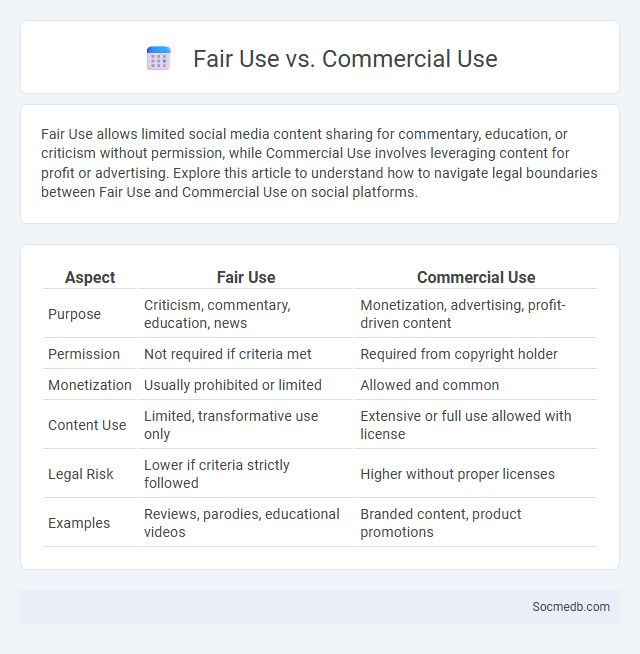
Photo illustration: Fair Use vs Commercial Use
Fair Use allows limited social media content sharing for commentary, education, or criticism without permission, while Commercial Use involves leveraging content for profit or advertising. Explore this article to understand how to navigate legal boundaries between Fair Use and Commercial Use on social platforms.
Table of Comparison
| Aspect | Fair Use | Commercial Use |
|---|---|---|
| Purpose | Criticism, commentary, education, news | Monetization, advertising, profit-driven content |
| Permission | Not required if criteria met | Required from copyright holder |
| Monetization | Usually prohibited or limited | Allowed and common |
| Content Use | Limited, transformative use only | Extensive or full use allowed with license |
| Legal Risk | Lower if criteria strictly followed | Higher without proper licenses |
| Examples | Reviews, parodies, educational videos | Branded content, product promotions |
Understanding Fair Use: Definition and Principles
Fair use is a legal doctrine that allows limited use of copyrighted materials without permission for purposes such as commentary, criticism, news reporting, education, and research. Key principles include the purpose of use, the nature of the copyrighted work, the amount used, and the effect on the market value of the original work. Understanding these factors helps social media users responsibly share content while respecting intellectual property rights.
What Constitutes Commercial Use?
Commercial use on social media involves promoting products, services, or brands with the intent to generate revenue or business opportunities. Activities like advertising, influencer partnerships, sponsored posts, and selling directly through social platforms fall under this category. Understanding what constitutes commercial use helps you comply with platform policies and avoid account restrictions or legal issues.
Key Differences Between Fair Use and Commercial Use
Fair use permits limited use of copyrighted material without permission for purposes like commentary, criticism, or education, focusing on non-commercial intent. Commercial use involves exploiting content for profit, typically requiring explicit authorization to avoid infringement. Understanding these distinctions helps you legally navigate content sharing and monetization on social media platforms.
Legal Framework Surrounding Fair Use
The legal framework surrounding fair use in social media is governed primarily by copyright law, which allows limited use of copyrighted content without permission under specific conditions such as commentary, criticism, and educational purposes. Courts evaluate fair use claims based on four key factors: the purpose and character of the use, the nature of the copyrighted work, the amount used, and the effect on the market value of the original. Social media platforms must carefully navigate these regulations to balance content sharing and intellectual property rights, often implementing automated tools and policies to mitigate infringement risks.
Examples of Fair Use in Practice
Fair use in social media frequently involves sharing short video clips for commentary, such as reaction videos or critiques under platforms like YouTube. Text-based posts often incorporate brief excerpts from books, articles, or speeches for educational or news reporting purposes on sites like Twitter and Facebook. Memes and parody content widely utilize copyrighted images and media while transforming the original context, which supports fair use protections in online communities.
Commercial Use Scenarios and Implications
Social media platforms drive commercial use scenarios by enabling targeted advertising, influencer marketing, and real-time customer engagement, which significantly boost brand visibility and sales. Businesses leverage data analytics from social media interactions to tailor campaigns and optimize user experience, increasing conversion rates and customer loyalty. The implications include enhanced market reach and personalized marketing strategies, while raising concerns around data privacy and advertising transparency.
Copyright Infringement: Risks and Consequences
Copyright infringement on social media jeopardizes your account by exposing you to legal risks, including fines and potential lawsuits for unauthorized use of protected content. Using copyrighted images, videos, or music without permission can result in content removal, account suspension, and damage to your online reputation. Understanding copyright laws and obtaining proper licenses protect your social media presence from these costly consequences.
Fair Use vs. Commercial Use: Common Misconceptions
Many users mistakenly believe that all content shared on social media is free for commercial use, but Fair Use strictly allows limited use for commentary, criticism, or educational purposes, not for profit-driven activities. Your understanding of the distinction between Fair Use and Commercial Use is crucial to avoid copyright infringement and potential legal consequences. Platforms like Instagram and YouTube enforce strict policies that protect original creators, requiring permission or licenses for using content in commercial contexts.
Tips for Navigating Fair Use and Commercial Use
When using social media content, understanding fair use guidelines is crucial to avoid copyright infringement, especially when sharing or modifying others' posts. Your best approach includes attributing original creators, limiting use to transformative or educational purposes, and avoiding full-length reposts of copyrighted material. For commercial use, securing explicit permissions or licenses ensures your content remains compliant while protecting both your brand and the rights holders.
Conclusion: Making Informed Content Decisions
Analyzing engagement metrics and audience demographics enables marketers to create targeted social media content that resonates effectively. Leveraging data-driven insights from platforms like Facebook Analytics and Instagram Insights enhances content relevance and boosts conversion rates. Consistently refining strategies based on performance analytics ensures optimized reach and sustained audience growth.
 socmedb.com
socmedb.com